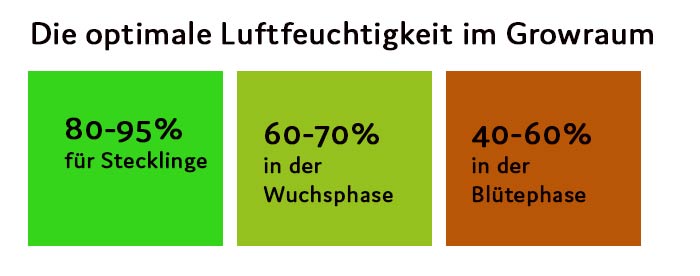With a little background knowledge and the necessary basic equipment, it is not difficult to grow cannabis. You can get the necessary growing accessories and equipment in our grow shop. Even if you have never grown indoors before, you can quickly learn the basics.
In the following, you will learn more about choosing the right seeds, germinating seeds, indoor lighting, fertilisers for cannabis plants, the climate for indoor growing and important tips for indoor growing. Basically, cannabis can be grown under different conditions and on different substrates. For small growing rooms and grow tents, autoflowering strains and cannabis varieties that do not grow too tall and remain compact are particularly suitable.
In our seed shop you will find a wide selection of excellent and award-winning cannabis seeds that are very suitable for indoor growing. Most growers use either feminised or autoflowering seeds for indoor growing.
Feminised cannabis seeds
Feminised seeds receive 16-24 hours of light per day in the first weeks. The plants only start flowering when the daily exposure time is reduced to 12 hours. As soon as the exposure time is reduced to 12 hours, the plants start flowering. The flowering period lasts 8-12 weeks for most cannabis strains. Some very fast strains become ready for harvest after 7 weeks.
Fast flowering cannabis strains are usually Indica dominant, e.g. many Kush strains. Some sativa dominant strains take as long as 15 weeks to finish flowering. Feminised seeds, as the name suggests, only produce female cannabis plants.
Autoflowering Seeds
Autoflowering seeds are now always feminised and take about 80 days from germination to harvest, depending on the variety, with 20 hours of light per day. Autoflowering cannabis seeds are easy to grow, quick to finish and do not require much effort. That's why they are appreciated by many growers and are especially recommended for beginners.
Autoflowering varieties grow to an average height of 1 m and now display amazing potency.
Just as with feminised and regular seeds, indicas generally become smaller plants, while sativas grow taller and stretch significantly as they flower. Sativa dominant plants always have a longer life cycle than indica dominant cannabis strains. This applies to photoperiod plants as well as autoflowering varieties.
CBD-rich cannabis seeds
CBD-rich cannabis seeds produce cannabis that contains 2% CBD or more. The seeds are especially popular among medical growers and produce cannabis that contains less or virtually no THC. CBD cannabis seeds are available in feminised or autoflowering varieties.
Regular cannabis seeds
Regular cannabis seeds produce about 50% female plants and 50% male plants. They are popular with older and experienced growers as well as those who want to grow their own. Here, the male plants have to be sorted out early at the beginning of flowering or preferably already at pre-flowering to prevent unwanted pollination of the female plants. For less experienced growers, this is more difficult and also requires more time.
Choosing the right cannabis strain
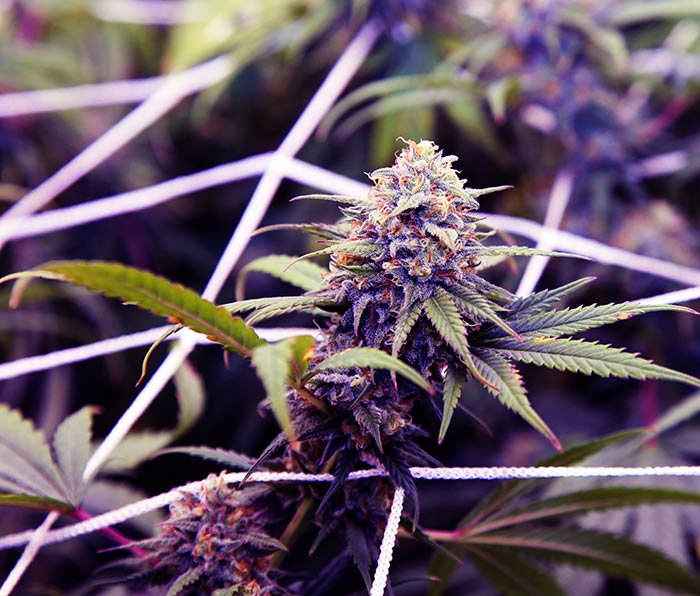
Choosing the right cannabis strain is of great importance. The yield and quality of the indoor harvest depend mainly on these factors:
- The quality of the seeds
- Duration of the growing phase
- Duration of the flowering period
- Optimum climate conditions in the growing room
- Sufficient and correct supply of nutrients
If two "pure-bred" and different plants (a male plant and a female plant) are crossed with each other, the so-called F1 hybrids are created. F1 hybrids have a special "hybrid strength", produce vigorous and high-yielding plants that have a uniform growth. "F1 plants" are often even much stronger than their parents.
Germinate cannabis seeds
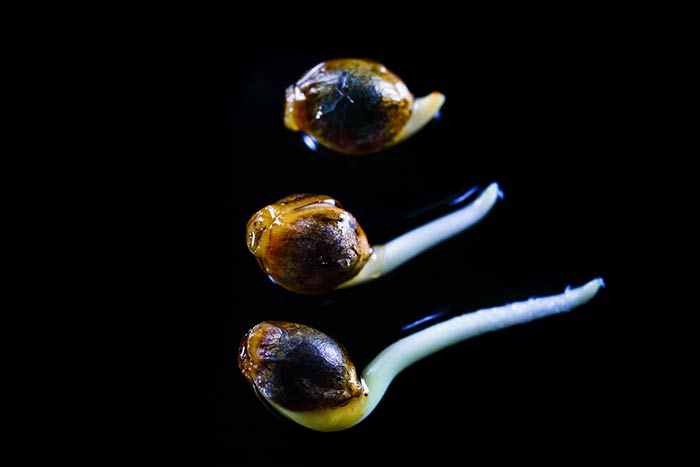
There are several ways to germinate cannabis seeds. In our article "Germinating cannabis seeds" you will find different ways to germinate. The easiest way to germinate cannabis seeds is to simply put them in a 1cm deep hole in the cannabis soil. The soil must then be kept moist, but not wet, for a few days. Some growers use a small greenhouse for this purpose, which should be aired several times a day so that mould cannot develop. The seeds should be kept at 20-25° C. This is the ideal germination temperature. This is the ideal germination temperature, below which the seeds get the kick to germinate.
Some growers cultivate with cuttings (= clones), which is an alternative to growing with seeds. This requires a particularly beautiful and outstanding mother plant. You can read more about this topic "Making cuttings yourself you can read here.
In the first initial phase, the seedlings need and want a light with less light intensity. If a NDL light (sodium vapour lamp) is used, it is necessary to keep a metre's distance from the light so that the plants do not burn. ESL light (energy-saving lamps) is brought closer to the plants: about 15-20 cm distance from the tips of the plants.
The seedlings receive artificial lighting of 18-25 hours per day right from the start. The lighting should always take place in the same time window. During this time, the small plants are in the growing phase. The root system is forming, branches and leaves are formed, but no buds yet.
The growing phase can take 2-6 weeks depending on the variety and the desired final size of the plants.
Send the cannabis plants into flowering
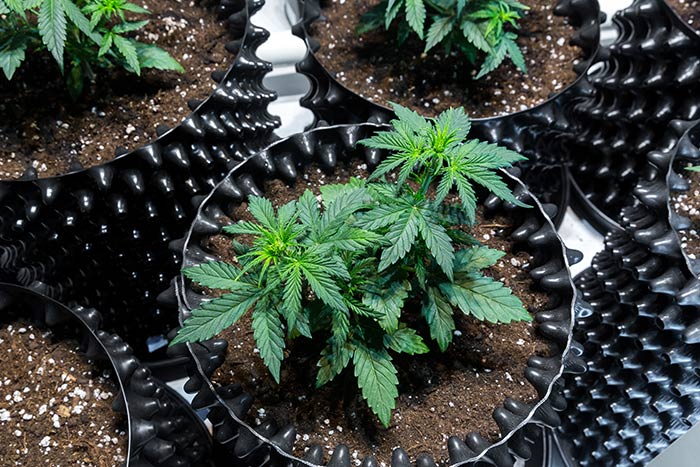
When the cannabis plants have reached a certain size, they are placed again in a larger plant pot and then sent into flowering. This happens when the daily lighting time is reduced to 12 hours. The plants are then under a sufficiently strong light for 12 hours and in absolute darkness for 12 hours. After changing the daily exposure time, it only takes a few days until the first hairs and flower buds can be seen. The flowering phase usually lasts 8-12 weeks. The length of the flowering period depends very much on the cannabis variety.
During the flowering period, the female cannabis plants form large buds and have a particularly high demand for light and nutrients. At the end of the flowering phase, when the unpollinated buds are ripe, the plants are harvested and the flowers are dried.
To get the full potency and the highest yield, many growers harvest when the trichomes on the buds have changed from clear to milky or amber coloured. This is when the buds are largest and have the highest potency. You can only see the trichomes with a good magnifying glass or microscope. The maturity of the flowers is often accompanied by the discolouration of the hairs from white, yellowish to brown/orange. However, this is by no means always a sure indication that the plants are really ripe. Some varieties or in certain circumstances, brown hairs form early, even if the plants are not yet ripe.
Some growers prefer grass that was harvested earlier, when the trichomes were mostly milky. This grass is more stimulating and activating. Other growers prefer grass that was harvested when most of the trichomes were amber. This weed is more physical and relaxing. Growers who grow their own cannabis can decide for themselves which high they prefer and this can go some way to deciding when to harvest.
Basically, the longer the growth phase, the bigger the plants will be. The yields will be correspondingly higher. In the flowering period, many cannabis plants really get going and double or triple their original size.
In the Sea-of-Green method, the plants are left to grow for only a few days before being sent into flower. This method produces only small plants with less yield, but this is compensated by the fact that more plants can be grown and the overall production is relatively fast. With enough plants, very good to great yields can be achieved on one m².
Grow light for indoor plants
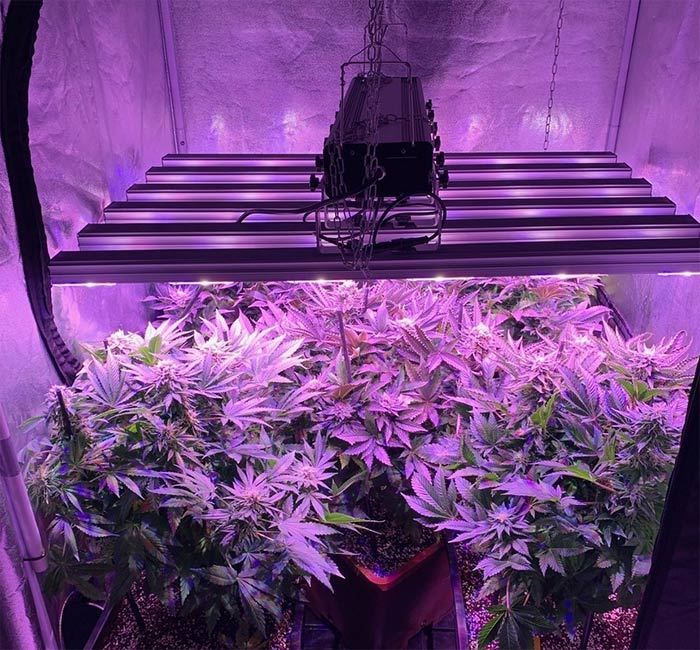
Successful growers give their plants as much light as possible with the right light spectrum. The absolute minimum for one m² is a 250W NDL lamp. In fact, a 400W NDL lamp is ideal for one m². If this is reduced, the buds will be correspondingly smaller, less dense, less potent and the overall yield will be lower. You should always pay attention to the correct distance from the top of the plant to the grow light. If the plant light is too far away from the plants, they will grow weaker and the buds will remain smaller. If the plant light is too close to the plant tips, parts of the plant can burn and damage the plant.
Many indoor growers have a small grow tent with 80 x 80 cm, 100 x 100 cm or 120 x 120 cm, which is lit with 250W-600W. Of course, appropriately powerful plant LEDs (200-400W) can also be used. This helps to save electricity and produces a broad light spectrum that is useful for cannabis plants.
As flowering progresses, beginners find that some varieties grow much taller than expected. The plants grow too close to the lamp. This should be prevented, of course, because it damages the plants. In this case, the plants are tied down with a string or a Trellinet so that they have less height. Another possibility is to prune the plants and thus shorten them. You can read more about plant light and the right distance to the lamp here.
High-quality plant LEDs have been sufficiently tested and bring the optimal light spectrum for cannabis plants for the different stages of development. With high-quality LEDs, plants produce higher THC and cannabinoid and terpene levels than with conventional plant lamps. Many growers prefer LED lamps because they generate less heat in the grow room and therefore require less powerful fans. Overall, the energy consumption is lower and they produce very high quality buds. When temperatures rise in the summer, it can sometimes be difficult to keep the temperature at the ideal level with NDL lamps. With LEDs, there are hardly any problems at this point and besides, LEDs are already fully wired and can be used immediately without prior knowledge.
With the help of plant training methods and pruning, you can influence and control the growth and even the yield. Learn more about this here.
The right nutrients for cannabis plants
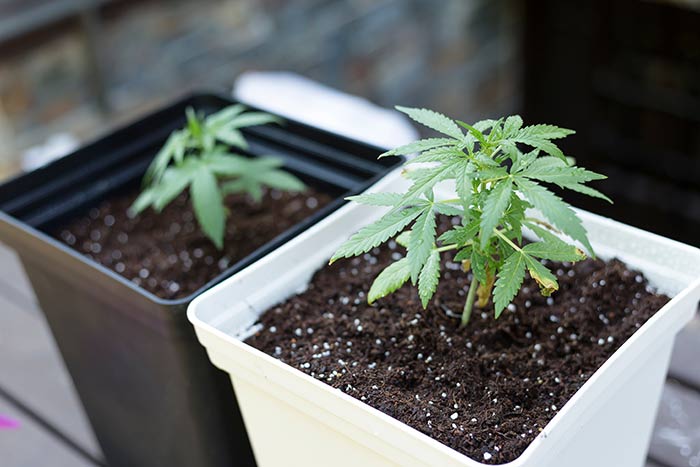
If you grow indoors, you should know a few things about the important nutrients for cannabis plants. It's not difficult to understand. Actually, cannabis fertilizers always do the same thing, they bring the necessary nutrients to the roots and are absorbed by them, whether growing on soil or hydroponically.
Fertiliser must be applied to every medium. Also on soil, then when the nutrients contained in the soil are depleted. Cannabis fertilisers have exact dosage and application information on their label on the bottle. Using more fertiliser does not mean that plants will grow faster or produce higher yields. On the contrary, over-fertilising, i.e. using too much cannabis fertiliser, can severely damage the plants and lead to significant crop losses. If you follow the manufacturer's instructions exactly, you can avoid over-fertilisation or even nutrient deficiencies.
Mineral cannabis fertiliser is mainly used in hydroponic cultivation. It does not clog nozzles and pumps, is soluble in water, and usually consists of a clear, transparent liquid that contains the necessary nutrients. During the growing phase, a fertiliser is used that has been specially developed for this phase and contains exactly the nutrients that the plant needs at this time. In the flowering phase, the plants then need other nutrients and a special fertiliser for the flowering phase is used. All well-known manufacturers such as Plagron, CANNA, Hesi, BioBizz, Advanced Hydroponics, BAC, GHE etc. have developed fertilisers that are adapted to the growing and flowering period.
There are clear differences in organic cultivation. Here, various organic and plant substances are provided, which then compost and break down in the planting medium so that they are available to the plants as food. In organic cultivation, nutrients are released piecemeal. There are organic fertilisers in tablet form, e.g. from Biotabs or BAC, in liquid form, as powder or pelletised.
Organic liquid fertiliser must be shaken well before use. Organic fertilisers are generally not suitable for hydroponic cultivation because they clog pumps and nozzles.
If you grow in large plant pots with a lot of soil and use a All-Mix or Complete-Mix then the nutrients in the soil should be sufficient for a few weeks, so that you do not need to add fertiliser to the water. It may only be necessary to use a special flowering fertiliser during the flowering phase. If you grow in small plant pots and use a light mix, you should also use a growth fertiliser according to the manufacturer's instructions.
When growing on coco-susbtrate, a special coco fertiliser should be used. Coco fertiliser is often available as a 2-phase fertiliser e.g. Organic Nova Coco
The pH value
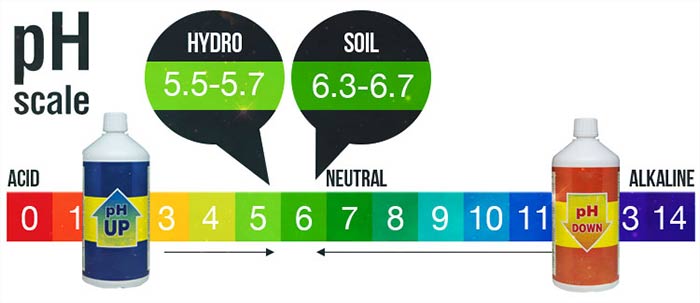
It is easy to measure the pH. If you grow in soil and fertilise organically, pH is less important and you don't necessarily need to measure it. This is why growing on soil is recommended for beginners. Here, mistakes in fertilising or a less than ideal pH value are more easily forgiven by the plants. Over-fertilisation in organic cultivation is almost impossible. The soil acts as a natural buffer that protects the plants from rapid nutrient changes. In hydroponic systems, plants react immediately and directly when too many or too few nutrients are given.
When growing with coco substrate, it is important to measure the pH of the water, just as with hydroponic growing. It should be around 5.8-6. If the pH value is not correct, nutrients cannot be absorbed properly by the plants and deficiency symptoms occur, even though sufficient nutrients have been given. This cannot be solved by adding more fertiliser. The solution is the right pH value.
The pH value can be measured with a Test kit or a pH meter measured with a pH meter. PH meters have to be calibrated regularly, as it is stated in the description. Test kits are cheap, easy to use without prior knowledge.
The EC value
The EC value indicates how high the nutrient content of the nutrient solution or the irrigation water is. The more nutrients the nutrient solution contains, the higher the EC value. EC meters also need to be calibrated regularly. The EC value must be measured especially in hydroponic cultivation and cultivation with coco. If you grow organically on soil or fertilise with mineral fertiliser on soil and follow the fertilisation scheme exactly, you can do without measuring the EC value. This belongs more to advanced growing and is something for professionals who want to adjust the nutrients exactly to individual plants or varieties and integrate their own knowledge or grow hydroponically.
Indoor cultivation allows plants to be grown under controlled conditions without harmful influences such as diseases, pests, storms, too much rain etc. damaging the plants. With the right equipment, a functioning indoor cultivation system is created that allows you to grow very high quality cannabis yourself, much better than that from the street.
Manage the smell
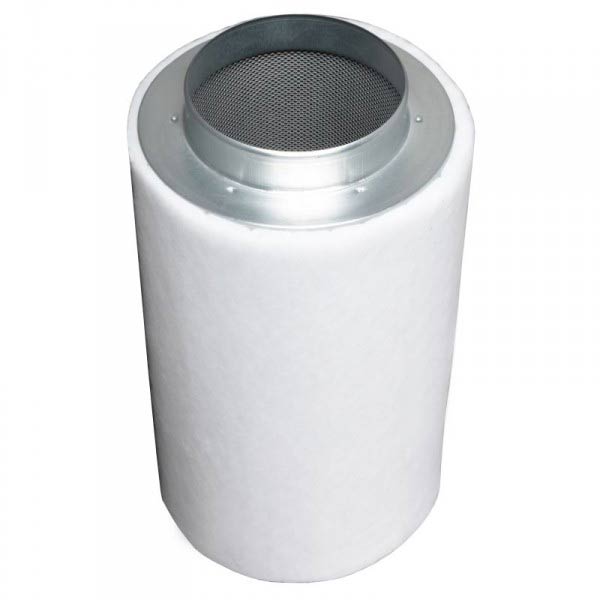
One of the main issues with indoor growing, is odour. Because cannabis can smell over 10 houses without an adequate air filter, a functioning and powerful one needs to be Activated carbon filter must be integrated into your cultivation system. The filter reliably cleans the air from any noticeable odours, so that only clean, odour-free air comes out of the grow cabinet. Check the charcoal filter regularly and make sure it is connected and working properly.
Growing cannabis indoors is booming and has never been more popular. It has become easy to produce your own super-high quality weed with high medicinal benefits, there has never been more choice of good growing systems and accessories, and people now know a lot about growing cannabis. Through the internet, knowledge could be connected and spread quickly.
The need for the right climate in the grow room
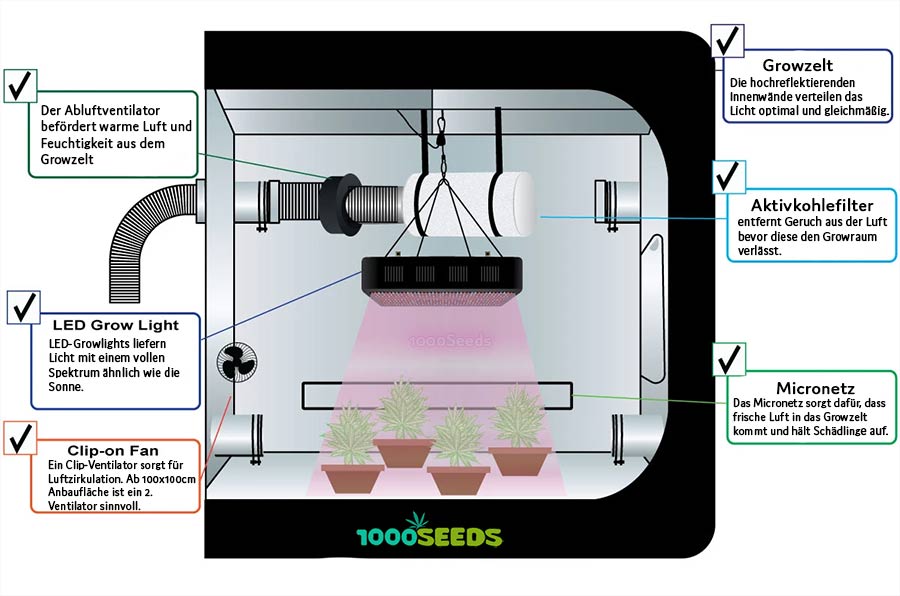
Nothing works without the right climate in the grow room. You can grow the best cannabis seeds and use the most expensive lamp, if the climate is not right, the results will be inferior. To grow the best cannabis, the temperature and humidity in the grow room must be suitable. Experienced growers aim for stable values that allow them to achieve the best results.
You should avoid rapid temperature changes in the grow room. It is recommended to use a Thermo-hygrometersto measure the temperature and humidity in the grow room. If the temperature is too high, the Fan should be switched up accordingly. A climate controller, to which the fan is connected, helps to control the right temperature and humidity in the grow room and to keep it stable.
If the temperature rises above 30° C, plants can only develop to a limited extent. The quality of the harvest can then be negatively affected.
A Exhaust fan must always be powerful enough for the activated charcoal filter used at the same time and allow the room air in the cultivation room to be completely exchanged about every 5 minutes. The warm, stale and humid air must be constantly and repeatedly transported out of the cultivation room with the help of the fan. If this important thing is not done, a successful grow will remain far away. Diseases and mould will quickly develop and the plants will not grow well. For a good climate, a closed cultivation room or a grow tent, which is always closed again after cultivation, is needed.
Many growers grow in the attic or basement. For both, it can be difficult to maintain the ideal temperature depending on the season. In winter and spring, the temperature can be too low, and in summer, the temperature rises too high. With a Grow room heater, Heaters or air conditioner, can bring the temperature to an optimal level. Avoid too strong and too fast temperature changes, as this can reduce the quality of the end product. Many a grow cabinet has moved from the cellar back into the flat because it was easier to create the right climate there.
Grow cabinets like the Homebox Ambient are not only solidly built and robust, they also look good in a room that is not used by visitors.
Humidity
Humidity is an important factor besides temperature. During the growing phase, the humidity in the grow room or grow tent should be 60-80%. Cuttings need 85-95% humidity, and in the flowering phase 50-60% humidity is ideal.
- 60%-80% humidity in the growing phase
- 50%-60% humidity during flowering
- Below 50% humidity at the end of the flowering period
- 85%-95% humidity for cuttings
The air humidity can be Dehumidifier or humidifier can be controlled.
Important indoor growing tips
- Cannabis plants need air circulation through 1 or better 2 circulating fans for a good development and for their metabolism.
- Yield can be increased by plant training methods, e.g. using the SCROG method.
- The ideal temperature in the grow room is between 21 and 25° C.
- It does not work without Activated carbon filter
- Odour neutralisers such as ONA Block or Zerum Pro help to eliminate additional odours
- If you are growing cannabis in soil, add a Perlite content of 25% for better aeration of the soil. However, many soil mixtures already contain perlite.
- The plants should not dry out, at the same time they must not be watered too much. Water when 2cm of the top layer of soil in the plant pot has become dry. Make sure that excess water can run away from the plant pot at any time.
- With the Rapitest you can determine the exact moisture of the soil and recognise when the plants need how much water.
- Avoid plant pots standing in water.
- Put (germinating) seeds in Light Mix or in a Seedmixwhich basically contains only few nutrients. If you use an all-mix with a high proportion of nutrients, you may get fall sickness and seedlings will die.
- For beginners, it is easier and safer to grow Indicas or Indica dominant cannabis strains because they mature faster, require less planting and are hardier.
- Successful indoor growing always starts with quality cannabis genetics. In our Seedshop you will find a large selection of high quality seeds from different seed banks.
You can find out more details about indoor growing in our detailed "Indoor Grow Manual







